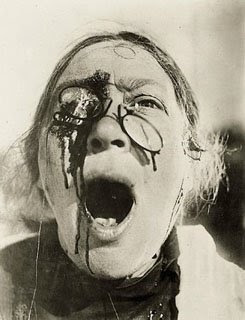GET GOOD AUDIO
Audio is as important, if not more than video image. Cannot emphasize this enough. Audiences watching films will gently dismiss quirks or experimentation with video grains, colorizations, treatments and even errors BUT if you mess up audio they have little or no toleration. Do not use the microphone on your consumer grade camera! Learn to capture good audio on location or collaborate with a professional location sound expert.
SHOW FACES
 In a comedy or dramatic scenario, it is important to get faces on the screen to get inside the emotion of your story. Everybody loves to look at faces.
In a comedy or dramatic scenario, it is important to get faces on the screen to get inside the emotion of your story. Everybody loves to look at faces. The great Russian father of film, Sergei Eisenstein with his experiments with juxtaposition, demonstrated that showing a person FACE, and then an event like in his Odessa steps sequence, evoked for an audience an emotion response to that event. Reaction shots make put the audience in the place of the character and leads them to imagine how they feel in the same situation.
All too often we find people shooting film that they are trying to cover the scene or set a shot that establishes location and it is very boring. Writers tend to want to shoot to cover dialogue and conversational interaction -- this is a mistake. Shoot to cover the human emotions and expressions inside the scene. Make sure you get significant reaction shots. Establish strong point of view (POV) with the use of camera shots of your characters and close ups and through their eye reveals.
BE BRIEF
As writers often say in the industry "Get in late, get out early" when talking about writing a scene. The surest thing to make your story uninteresting to to drag on and on and on trying to establish the scene and fail get to the point that scene is trying to deliver. Be as efficient as possible with exposition and storytelling.
GOOD LIGHTING
Knowing how to use lighting is essential. Just setting your camera up and a tripod and pushing the record button certainly is a recipe for really flat and boring images on the screen. Every shot needs to be considered and planned in advance for the effect of the lighting on the story. Lighting allows the eye to be directed and focused on where the story is, where it is going and the emotional drama of the scene.
If you don't feel you understand the science of lighting, get someone who does and is interested in lighting design. Knowing and using concepts like three point lighting, key lights, fill lights, soft light, hard light filters or knowing how to use natural light during mood moments of the day and the science of bouncing light, using flags and defusers if you are going entirely with a "natural light look" is criticala to building a visual style to match your dramatic and comic story.
AVOID DISTRACTING TECHNICAL NOISE
If you watch videos on YouTube or Google Video you quickly start to notice why things fail and why things work. One of the repeating mistakes of so many videos on these channels, and a common mistake for amateurs, is going off message or away from the story because of technical noise. Most commonly, when the camera is jerking around and constantly gyrating for no useful reason, we stop looking at the action, the characters and the story and start watching the irritation.
Think of it as a fly in the room. All of a sudden its buzzing next to your ear (audio) or circling next to your face (picture). Immediately, you stop looking and the beautiful scene on the lake, or the nice plate of food or the beautiful people around you in interesting conversation because the fly is an overwhelming distraction. I see this all the time on YouTube and most anyone in this rapid info and image age turns it off quickly in favor of less noisy transmissions of information or story.




No comments:
Post a Comment